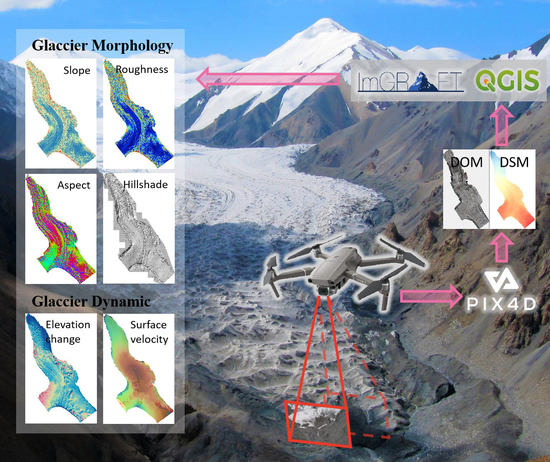Dynamic Monitoring of Laohugou Glacier No. 12 with a Drone, West Qilian Mountains, West China
Abstract
:1. Introduction
2. Materials and Methods
2.1. Study Area
2.2. Field Survey
2.3. Image Processing
2.4. Glacier Surface Displacement Extraction
2.5. Meteorologic Data
2.6. Uncertainty Estimation
3. Results
3.1. Changes in Terminus & Area
3.2. Surface Morphology
3.3. Surface Velocities
3.4. Changes of Surface Elevation
3.5. Climate Background
4. Discussion
5. Conclusions
- (1)
- The terminus of LHG12 retreated by 194.35 m in total and by 19.44 m a−1 on average during 2008–2021. Differential ablation may have led to changes in the morphology of the terminus edge. This caused a marked increase in the terminus’ retreat distance.
- (2)
- The dynamic characteristics of LHG12 were analyzed via drone-based photogrammetry, and differences in the surface velocity features between the west and east branches were found. The movement in the west branch is faster than it is in the east branch. Because of the extrusion of the two ice flows, there is a region with a faster surface velocity at the ablation area.
- (3)
- In 2019–2021, the maximum annual surface velocity was 6.50 cm day−1, and during ablation season, the maximum surface velocity was 13.59 cm day−1, 52.17% higher than it is annually. The surface velocity in the west branch was faster than it was in the east branch.
- (4)
- With the intensification of LHG12 ablation in recent decades, the ice thickness is decreasing, leading to the surface velocity decrease. This phenomenon is more obvious in large glaciers than it is in small glaciers in the Qilian mountains.
Author Contributions
Funding
Data Availability Statement
Acknowledgments
Conflicts of Interest
References
- Qin, D.; Ding, Y. Cryospheric Changes and Their Impacts:Present, Trends and Key Issues. Advabces Clim. Chang. Res. 2009, 5, 187–195. [Google Scholar] [CrossRef]
- Deng, G.; Tang, Z.; Hu, G.; Wang, J.; Sang, G.; Li, J. Spatiotemporal Dynamics of Snowline Altitude and Their Responses to Climate Change in the Tienshan Mountains, Central Asia, during 2001–2019. Sustainability 2021, 13, 3992. [Google Scholar] [CrossRef]
- Tang, Z.; Wang, X.; Deng, G.; Wang, X.; Jiang, Z.; Sang, G. Spatiotemporal variation of snowline altitude at the end of melting season across High Mountain Asia, using MODIS snow cover. Adv. Space Res. 2020, 66, 2629–2645. [Google Scholar] [CrossRef]
- Qin, D.; Yao, T.; Ding, Y.; Ren, J. Establishment and Significance of the Scientific System of Cryospheric Science. Bull. Chin. Acad. Sci. 2020, 35, 393–406. [Google Scholar] [CrossRef]
- Jansson, P.; Hock, R.; Schneider, T. The concept of glacier storage: A review. J. Hydrol. 2003, 282, 116–129. [Google Scholar] [CrossRef]
- Li, Z.; Li, K.; Wang, L. Study on Recent Glacier Changes and Their Impact on Water Resourcess in Xinjiang, North Westren, China. Quat. Sci. 2010, 30, 96–106. [Google Scholar] [CrossRef]
- Sorg, A.; Bolch, T.; Stoffel, M.; Solomina, O.; Beniston, M. Climate change impacts on glaciers and runoff in Tien Shan (Central Asia). Nat. Clim. Chang. 2012, 2, 725–731. [Google Scholar] [CrossRef]
- Liu, S.; Ding, Y.; Zhang, Y.; Shangguan, D.; Li, J.; Han, H.; Wang, J.; Xie, C. Impact of the glacial change on water resources in the Tarim River Basin. Acta Geogr. Sin. 2006, 61, 482–490. [Google Scholar] [CrossRef]
- Zhang, J.; He, X.; Shangguang, D.; Zhong, F.; Liu, S. Impact of Intensive Glacier Ablation on Arid Regions of Northwest China and Its Countermeasure. J. Glaciol. Geocryol. 2012, 34, 848–854. [Google Scholar]
- Liu, S.; Yao, X.; Guo, W.; Xu, J.; Shangguan, D.; Wei, J.; Bao, W.; Wu, L. The contemporary glaciers in China based on the Second Chinese Glacier Inventory. Acta Geogr. Sin. 2015, 70, 3–16. [Google Scholar] [CrossRef]
- Xu, C.; Li, J.; Wang, N. Climatic and environmental indications of stable oxygen isotopes in enclosed air bubbles in Tanggula ice core. J. Beijing Norm. Univ. (Nat. Sci.) 2019, 55, 145–152. [Google Scholar] [CrossRef]
- Tian, L.; Yao, T.; Wen, R.; Weng, Y.; Zhao, Z.; Qu, D. A primary recognition on the climatic significance of ice core isotope record in Naimona’ Nyi of west Tibetan Plateau. Quat. Sci. 2012, 32, 46–52. [Google Scholar] [CrossRef]
- Moon, T. Saying goodbye to glaciers. Science 2017, 356, 580–581. [Google Scholar] [CrossRef] [PubMed]
- Liu, S.; Wu, T.; Wang, X.; Wu, X.; Yao, X.; Liu, Q.; Zhang, Y.; Wei, J.; Zhu, X. Changes in the global cryosphere and their impacts: A review and new perspective. Sci. Cold Arid. Reg. 2020, 12, 343–354. [Google Scholar] [CrossRef]
- Kang, S.; Guo, W.; Zhong, X.; Xu, M. Changes in the mountain cryosphere and their impacts and adaptation measures. Clim. Chang. Res. 2020, 16, 143–152. [Google Scholar] [CrossRef]
- Li, X.; Gou, X.; Wang, N.; Sheng, Y.; Jin, H.; Qi, Y.; Song, X.; Hou, F.; Li, Y.; Zhao, C.; et al. Tightening ecological management facilitates green development in the Qilian Mountains. Chin. Sci. Bull. 2019, 64, 2928–2937. [Google Scholar] [CrossRef] [Green Version]
- Zhu, M.; Yao, T.; Thompson, L.G.; Wang, S.; Yang, W.; Zhao, H. What induces the spatiotemporal variability of glacier mass balance across the Qilian Mountains. Clim. Dyn. 2022, 1–23. [Google Scholar] [CrossRef]
- Sun, M.; Liu, S.; Yao, X.; Guo, W.; Xu, J. Glacier changes in the Qilian Mountains in the past half-century: Based on the revised First and Second Chinese Glacier Inventory. J. Geogr. Sci. 2018, 28, 206–220. [Google Scholar] [CrossRef] [Green Version]
- Liu, Y.; Qin, X.; Du, W. Changes of glacier area in the Xiying River Basin, East Qilian Mountain, China. Sci. Cold Arid. Reg. 2017, 9, 432–437. [Google Scholar] [CrossRef]
- Wang, P.; Li, Z.; Yu, G.; Li, H.; Wang, W.; Huai, B.; Zhou, P.; Jin, S.; Wang, L.; Zhang, H. Glacier shrinkage in the Daxue and Danghenan ranges of the western Qilian Mountains, China, from 1957 to 2010. Environ. Earth Sci. 2016, 75, 127. [Google Scholar] [CrossRef]
- Wang, Y.; Hou, S.; Hong, S.; Liu, Y. Glacier extent and volume change (1966-2000) on the Su-lo Mountain in northeastern Tibetan Plateau, China. J. Mt. Sci. 2008, 5, 299–309. [Google Scholar] [CrossRef]
- Yu, G.; Li, Z.; Wang, P. Glacier changes at the Daxue Mountain and Danghenan Mountain of west Qilian Mountains in recent 50 years. Arid. Land Geogr. 2014, 37, 299–309. [Google Scholar] [CrossRef]
- Wang, Y.; Li, J.; Wu, L.; Guo, L.; Li, J. Using remote sensing images to monitor the glacier changes in Qilian Mountains during 1987—2018 and analyzing the impact factors. J. Glaciol. Geocryol. 2020, 42, 344–356. [Google Scholar] [CrossRef]
- Bhardwaj, A.; Sam, L.; Akanksha; Martín-Torres, F.J.; Kumar, R. UAVs as remote sensing platform in glaciology: Present applications and future prospects. Remote Sens. Environ. 2016, 175, 196–204. [Google Scholar] [CrossRef]
- Wang, Y.; Ren, J.; Qin, D.; Qin, X. Regional Glacier Volume Changes Derived from Satellite Data: A Case Study in the Qilian Mountains. J. Glaciol. Geocryol. 2013, 35, 583–592. [Google Scholar] [CrossRef]
- Wang, P.; Li, Z.; Li, H.; Li, K.; Xu, C. Analysis of the relation between glacier volume change and area change in the Tianshan Mountains. J. Glaciol. Geocryol. 2017, 39, 9–15. [Google Scholar] [CrossRef]
- Banerjee, A. Volume-area scaling for debris-covered glaciers. J. Glaciol. 2020, 66, 880–886. [Google Scholar] [CrossRef]
- Radić, V.; Hock, R.; Oerlemans, J. Volume–area scaling vs flowline modelling in glacier volume projections. Ann. Glaciol. 2007, 46, 234–240. [Google Scholar] [CrossRef] [Green Version]
- Zhao, C.; Yang, W.; Wang, Y.; Ding, B.; Xu, X. Changes in surface elevation and velocity of Parlung No.4 glacier in southeastern Tibetan Plateau: Monitoring by UAV technology. J. Beijing Norm. Univ. (Nat. Sci.) 2020, 56, 557–565. [Google Scholar] [CrossRef]
- Wang, P.; Li, H.; Li, Z.; Liu, Y.; Xu, C.; Mu, J.; Zhang, H. Seasonal Surface Change of Urumqi Glacier No. 1, Eastern Tien Shan, China, Revealed by Repeated High-Resolution UAV Photogrammetry. Remote Sens. 2021, 13, 3398. [Google Scholar] [CrossRef]
- Ramsankaran, R.; Navinkumar, P.; Dashora, A.; Kulkarni, A. UAV-Based Survey of Glaciers in Himalayas: Challenges and Recommendations. J. Indian Soc. Remote Sens. 2021, 49, 1171–1187. [Google Scholar] [CrossRef]
- Jouvet, G.; van Dongen, E.; Lüthi, M.; Vieli, A. In situ measurements of the ice flow motion at Eqip Sermia Glacier using a remotely controlled unmanned aerial vehicle (UAV). Geosci. Instrum. Methods Data Syst. 2020, 9, 1–10. [Google Scholar] [CrossRef] [Green Version]
- Fugazza, D.; Scaioni, M.; Corti, M.; D’Agata, C.; Azzoni, R.; Cernuschi, M.; Smiraglia, C.; Diolaiuti, G. Combination of UAV and terrestrial photogrammetry to assess rapid glacier evolution and map glacier. Nat. Hazards Earth Syst. Sci. 2018, 18, 1055–1071. [Google Scholar] [CrossRef] [Green Version]
- Liu, Y.; Qin, X.; Du, W.; Sun, W.; Hou, D. The movement features analysis of Laohugou Glacier No. 12 in Qilian Mountains. Sci. Cold Arid. Reg. 2011, 3, 119–123. [Google Scholar] [CrossRef]
- Chen, J.; Kang, S.; Qin, X.; Du, W.; Sun, W.; Liu, Y. The mass-balance characteristics and sensitivities to climate variables of Laohugou Glacier No. 12, western Qilian Mountains, China. Sci. Cold Arid. Reg. 2017, 9, 543–553. [Google Scholar] [CrossRef]
- Wang, Y.; Zhang, T.; Ren, J.; Qin, X.; Liu, Y.; Sun, W.; Chen, J.; Ding, M.; Du, W.; Qin, D. An investigation of the thermomechanical features of Laohugou Glacier No. 12 on Qilian Shan, western China, using a two dimensional first order flow band ice flow model. Cryosphere 2018, 12, 851–866. [Google Scholar] [CrossRef] [Green Version]
- Liu, Y.; Qin, X.; Chen, J.; Li, Z.; Wang, J.; Du, W.; Guo, W. Variations of Laohugou Glacier No. 12 in the western Qilian Mountains, China, from 1957 to 2015. J. Mt. Sci. 2018, 15, 25–32. [Google Scholar] [CrossRef]
- Sun, W.; Qin, X.; Ren, J.; Yang, X.; Zhang, T.; Liu, Y.; Cui, X.; Du, W. The Surface Energy Budget in the Accumulation Zone of the Laohugou Glacier No. 12 in the Western Qilian Mountains, China, in Summer 2009. Arct. Antarct. Alp. Res. 2012, 44, 296–305. [Google Scholar] [CrossRef] [Green Version]
- Liu, Y.; Qin, D.; Li, Y.; Qin, X.; Li, Z.; Wang, J.; Jin, Z.; Wang, L. Changes in the Surface Elevation of the Laohugou Glacier No. 12 in Western Qilian Mountains. Front. Earth Sci. 2022, 10, 1–9. [Google Scholar] [CrossRef]
- Wang, Y.; Ren, J.; Qin, X.; Liu, Y.; Zhang, T.; Chen, J.; Li, Y.; Qin, D. Ice depth and glacier-bed characteristics of the Laohugou Glacier No.12, Qilian Mountains, revealed by ground-penetrating radar. J. Glaciol. Geocryol. 2016, 38, 28–35. [Google Scholar] [CrossRef]
- The Technical Parameters of the PHANTOM 4 Pro. Available online: https://www.dji.com/cn/phantom-4-pro/info#specs (accessed on 15 May 2022).
- The Technical Parameters of the MAVIC 2 Pro. Available online: https://www.dji.com/cn/mavic-2/info#specs (accessed on 15 May 2022).
- Liu, Y.; Qin, X.; Guo, W.; Gao, S.; Chen, J.; Wang, L.; Li, Y.; Jin, Z. Influence of the use of photogrammetric measurement precision on low-altitude micro-UAVs in the glacier region. Natl. Remote Sens. Bull 2020, 24, 161–172. [Google Scholar] [CrossRef]
- The Technical Parameters of the SOUTH S86 and SOUTH INNO7 GNSS. Available online: https://www.southinstrument.com (accessed on 15 May 2022).
- The Ground Sampling Distance (GSD) in Photogrammetry. Available online: https://support.pix4d.com/hc/en-us/articles/202559809-Ground-sampling-distance-GSD-in-photogrammetry (accessed on 15 May 2022).
- The Home Page of the QGIS. Available online: https://www.qgis.org (accessed on 15 May 2022).
- Messerli, A.; Grinsted, A. Image georectification and feature tracking toolbox: ImGRAFT. Geosci. Instrum. Methods Data Syst. 2015, 4, 23–34. [Google Scholar] [CrossRef] [Green Version]
- Heid, T.; Kaab, A. Evaluation of existing image matching methods for deriving glacier surface displacements globally from optical satellite imagery. Remote Sens. Environ. 2012, 118, 339–355. [Google Scholar] [CrossRef]
- Lamsters, K.; Ješkins, J.; Sobota, I.; Karušs, J.; Džeriņš, P. Surface Characteristics, Elevation Change, and Velocity of High-Arctic Valley Glacier from Repeated High-Resolution UAV Photogrammetry. Remote Sens. 2022, 14, 1029. [Google Scholar] [CrossRef]
- Huang, M.; Sun, Z. Some Flow Characteristics of Continental-Type Glaciers in China. J. Glaciol. Geocryol. 1982, 4, 35–45. [Google Scholar]
- Chen, R.; Kang, E.; Ding, Y. Some knowledge on China’s alpine hydrology. Adv. Water Sci. 2014, 25, 308–317. [Google Scholar] [CrossRef]
- Jing, Z.; Wang, K.; Liu, L. Movement and variation of four typical glaciers in the Qilian Mountains, Northwestern China. Sci. Cold Arid. Reg. 2015, 7, 206–211. [Google Scholar] [CrossRef]
- Wang, K.; Jing, Z.; Wu, Y.; Deng, Y. Latest survey and study of surface flow features of the Qiyi Glacier in the Qilian Mountains. J. Glaciol. Geocryol. 2014, 36, 9. [Google Scholar]
- Cao, B.; Wang, J.; Pan, B.; Zhang, X.; Cui, H. Surface flow velocities of the Ningchanhe No.1 and Shuiguanhe No. 4 Glaciers in the East Qilian Mountains. J. Glaciol. Geocryol. 2013, 35, 8. [Google Scholar] [CrossRef]
- Liu, Y.; Qin, X.; Du, W.; Zhang, X.; Chen, J.; Xie, X.; Zhang, X. An analysis of flow features of the Ningchan River Glacier No. 3 in the Qilian Mountains. J. Glaciol. Geocryol. 2013, 35, 7. [Google Scholar] [CrossRef]
- Cao, B.; Guan, W.; Li, K.; Pan, B.; Sun, X. High-Resolution Monitoring of Glacier Mass Balance and Dynamics with Unmanned Aerial Vehicles on the Ningchan No. 1 Glacier in the Qilian Mountains, China. Remote Sens. 2021, 13, 2735. [Google Scholar] [CrossRef]
- Karimi, N.; Sheshangosht, S.; Roozbahani, R. High-resolution monitoring of debris-covered glacier mass budget and flow velocity using repeated UAV photogrammetry in Iran. Geomorphology 2021, 389, 107855. [Google Scholar] [CrossRef]
- Che, Y.; Wang, S.; Yi, S.; Wei, Y.; Cai, Y. Summer Mass Balance and Surface Velocity Derived by Unmanned Aerial Vehicle on Debris-Covered Region of Baishui River Glacier No. 1, Yulong Snow Mountain. Remote Sens. 2020, 12, 3280. [Google Scholar] [CrossRef]
- Davaze, L.; Rabatel, A.; Dufour, A.; Hugonnet, R.; Arnaud, Y. Region Wide Annual Glacier Surface Mass Balance for the European Alps From 2000 to 2016. Front. Earth Sci. 2020, 8, 149. [Google Scholar] [CrossRef]
- Miles, E.; McCarthy, M.; Dehecq, A.; Kneib, M.; Fugger, S.; Pellicciotti, F. Health and sustainability of glaciers in High Mountain Asia. Nat. Commun. 2021, 12, 2868. [Google Scholar] [CrossRef]
- Berthier, E.; Vincent, C. Relative contribution of surface mass balance and ice flux changes to the accelerated thinning of Mer de Glace, French Alps, over1979-2008. J. Glaciol. 2017, 58, 501–512. [Google Scholar] [CrossRef] [Green Version]
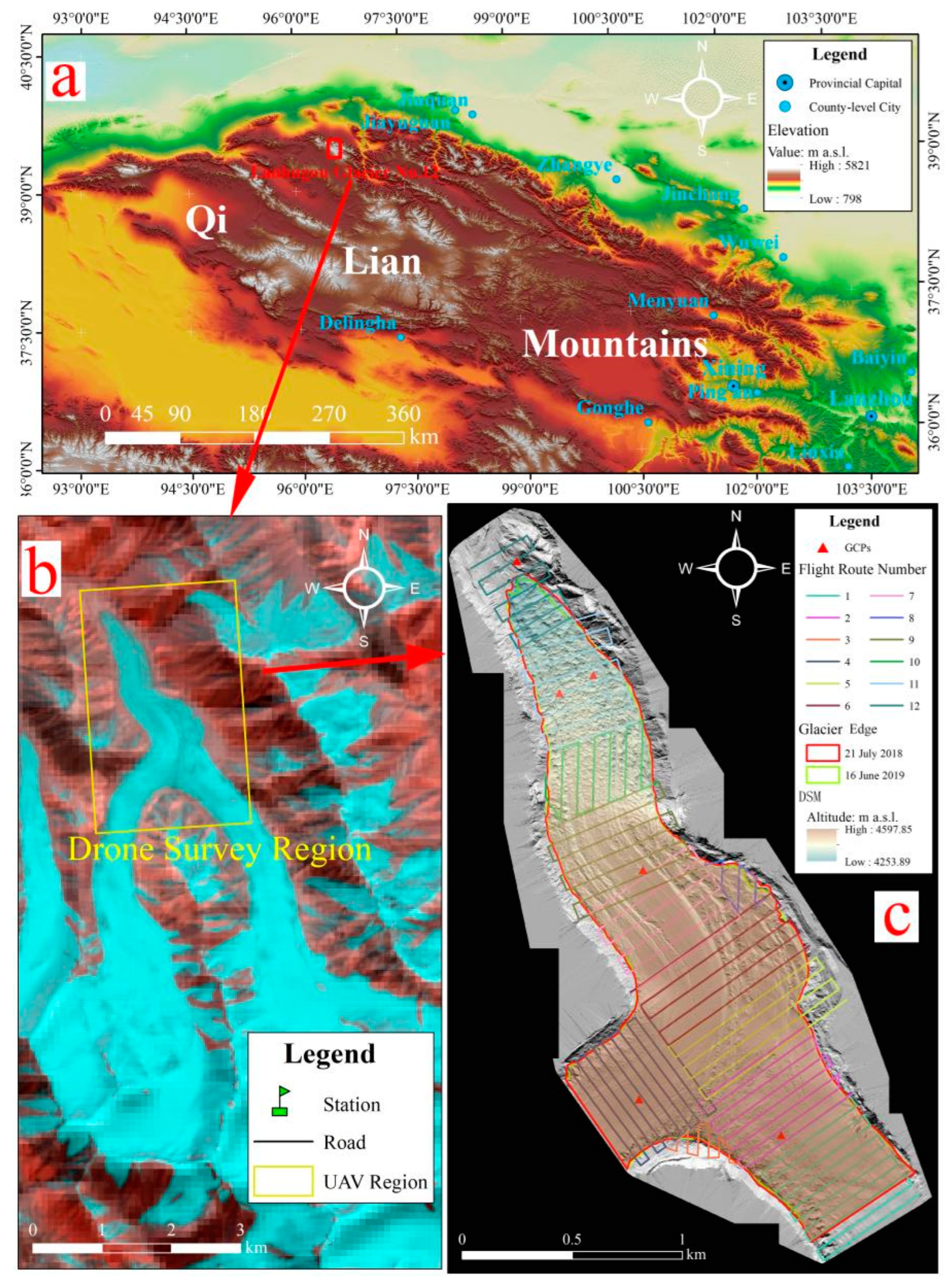
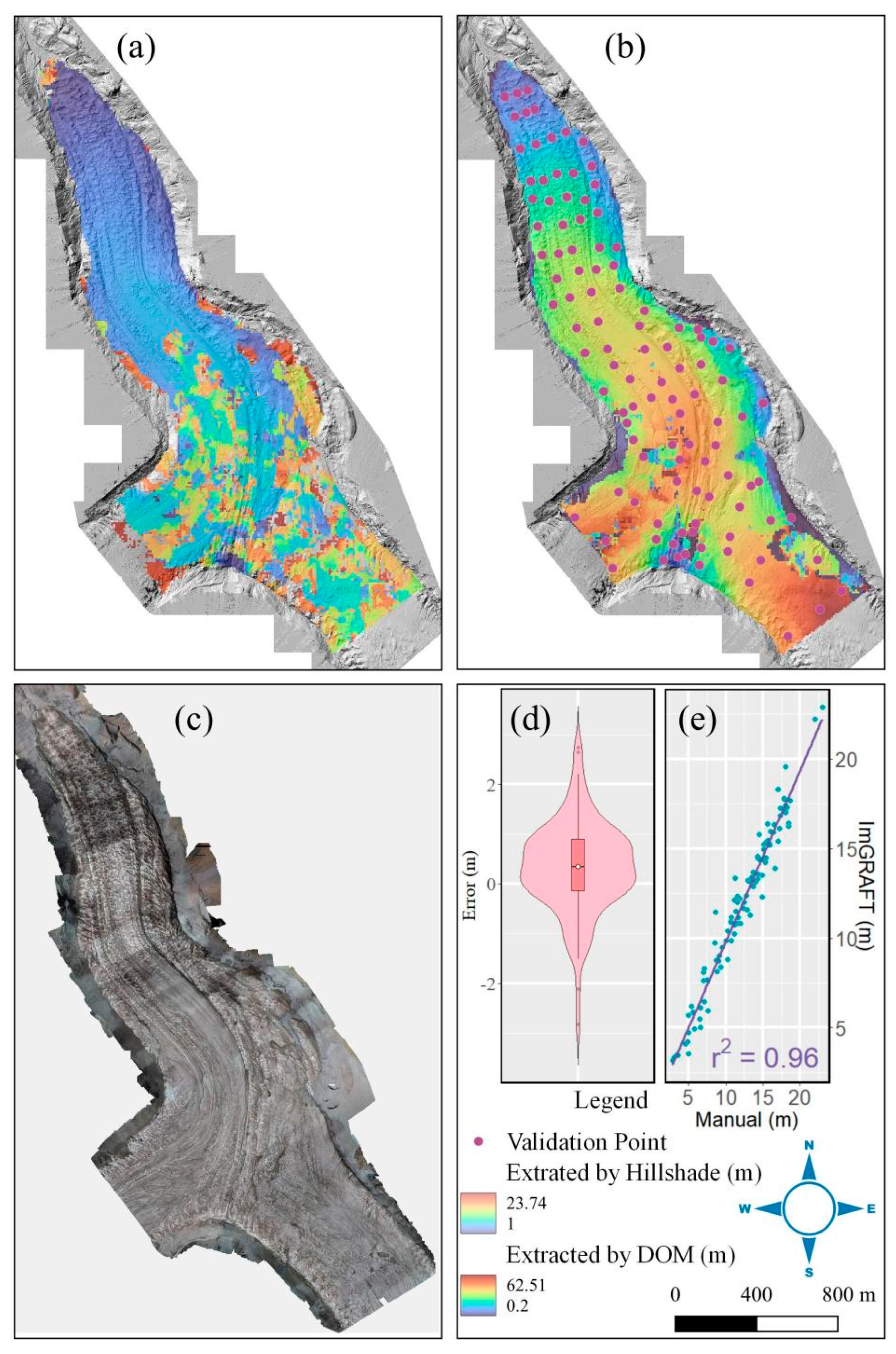

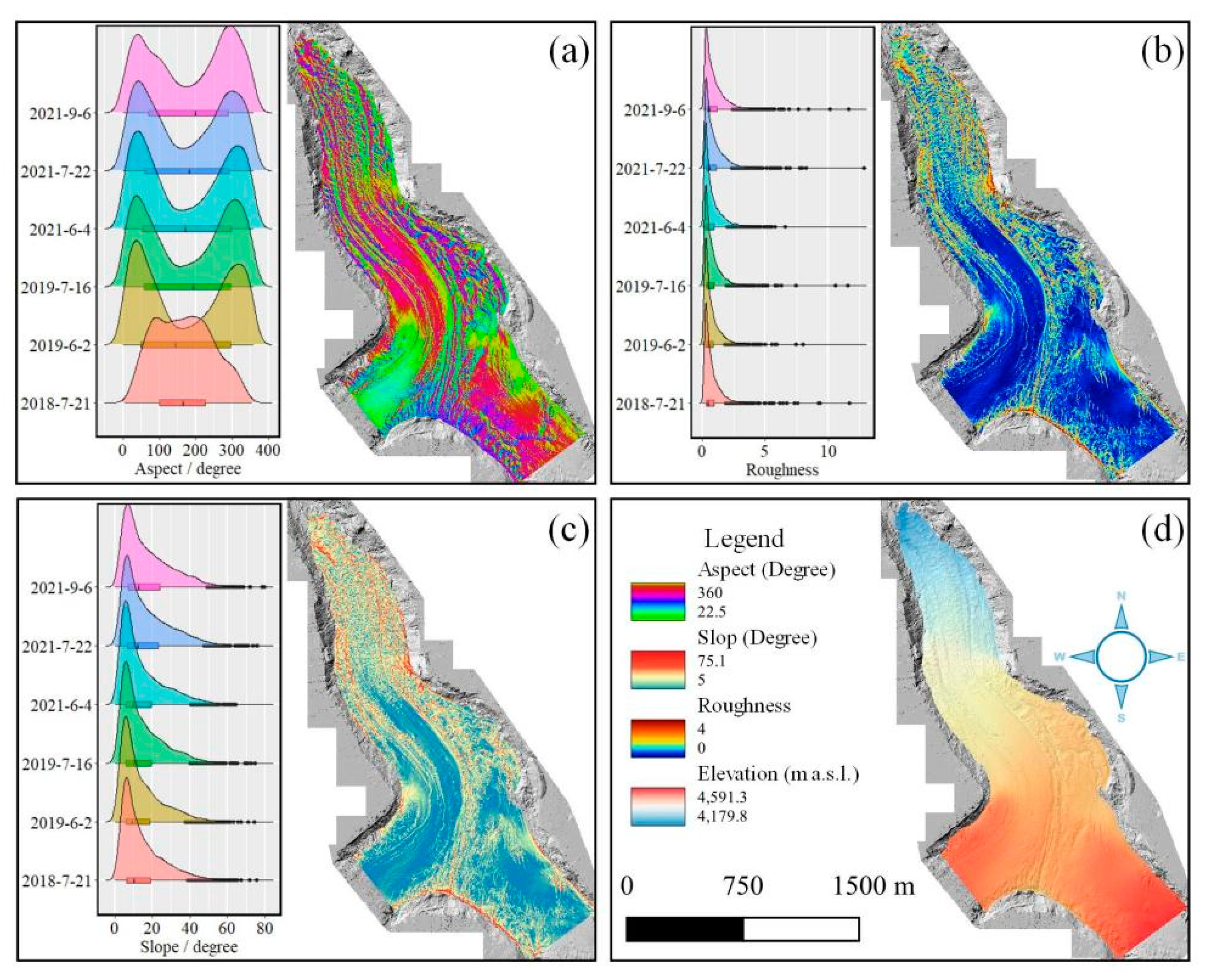
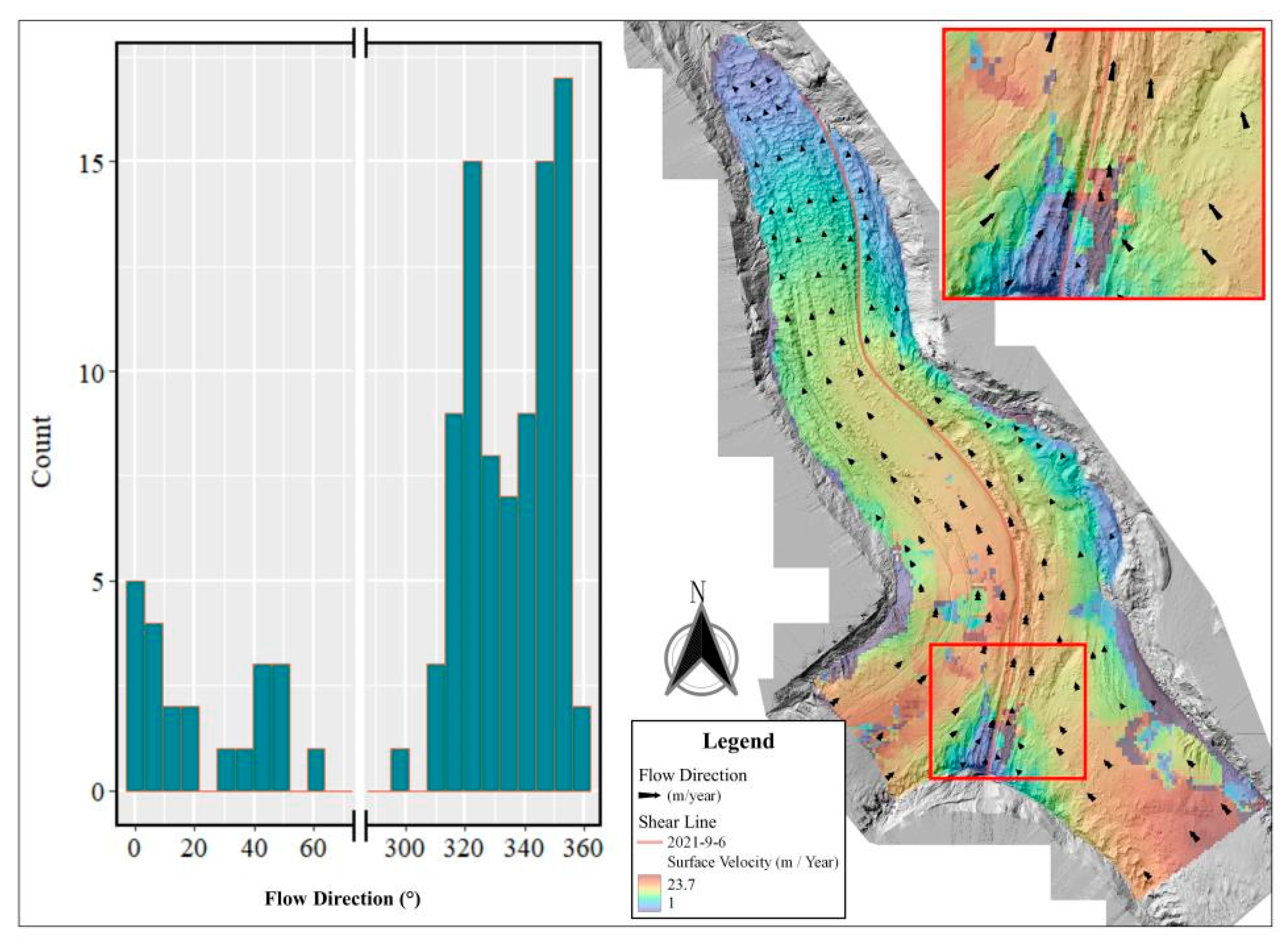


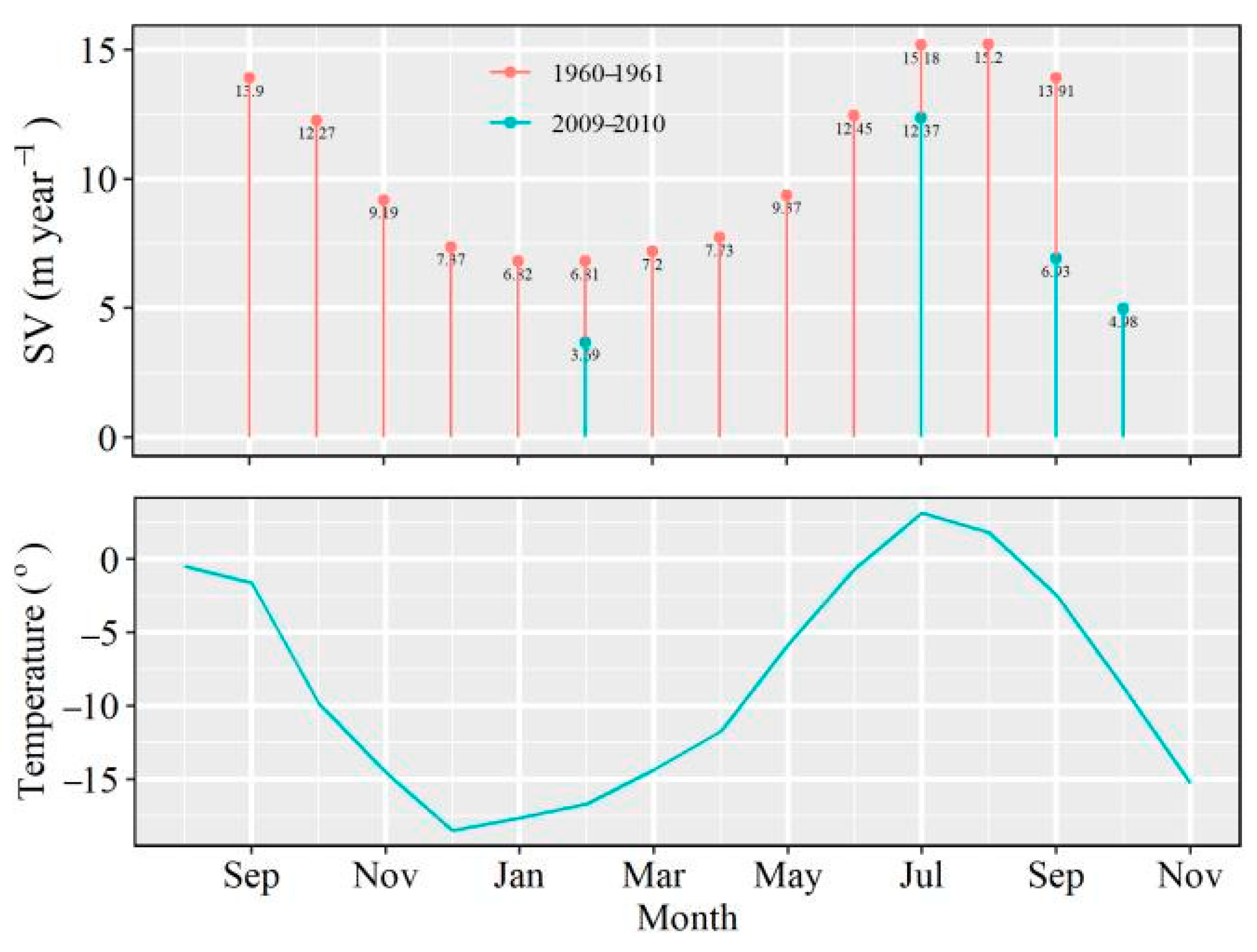
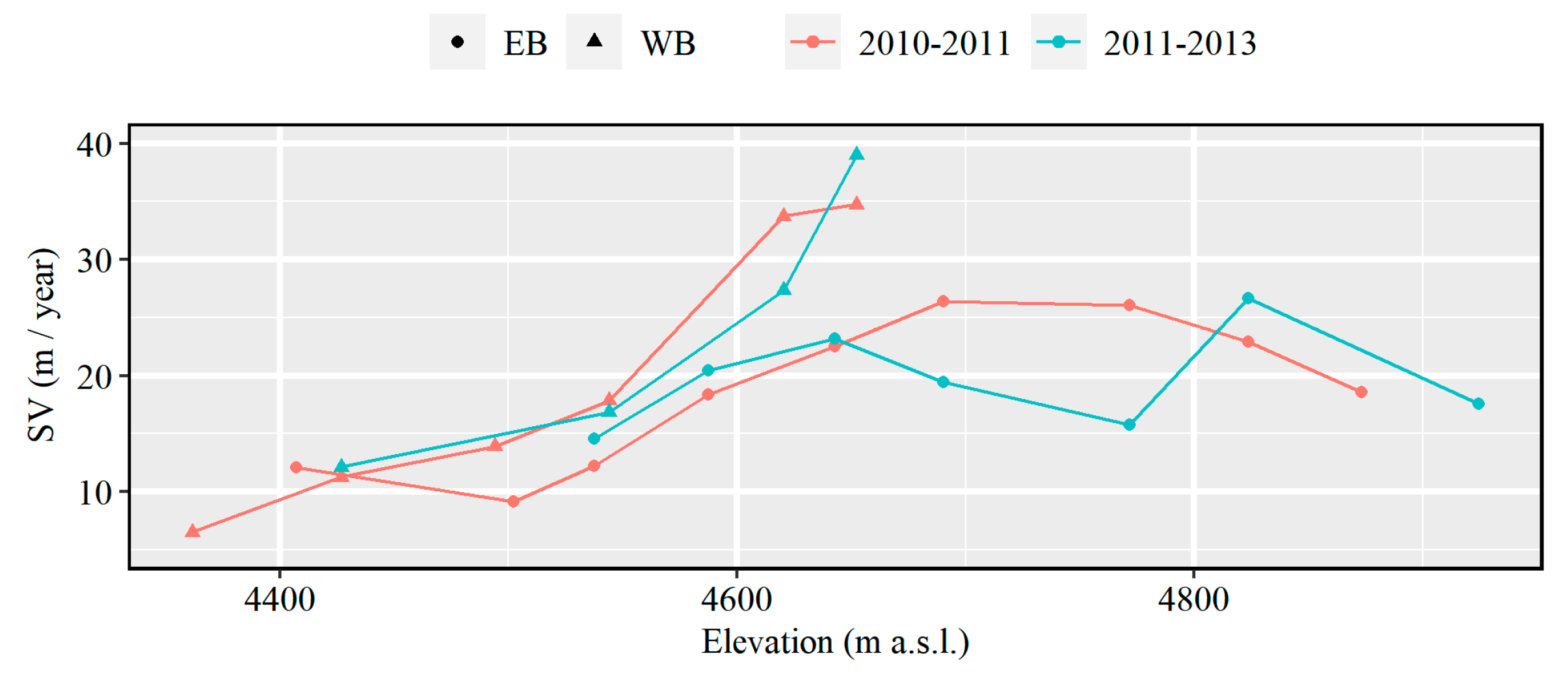
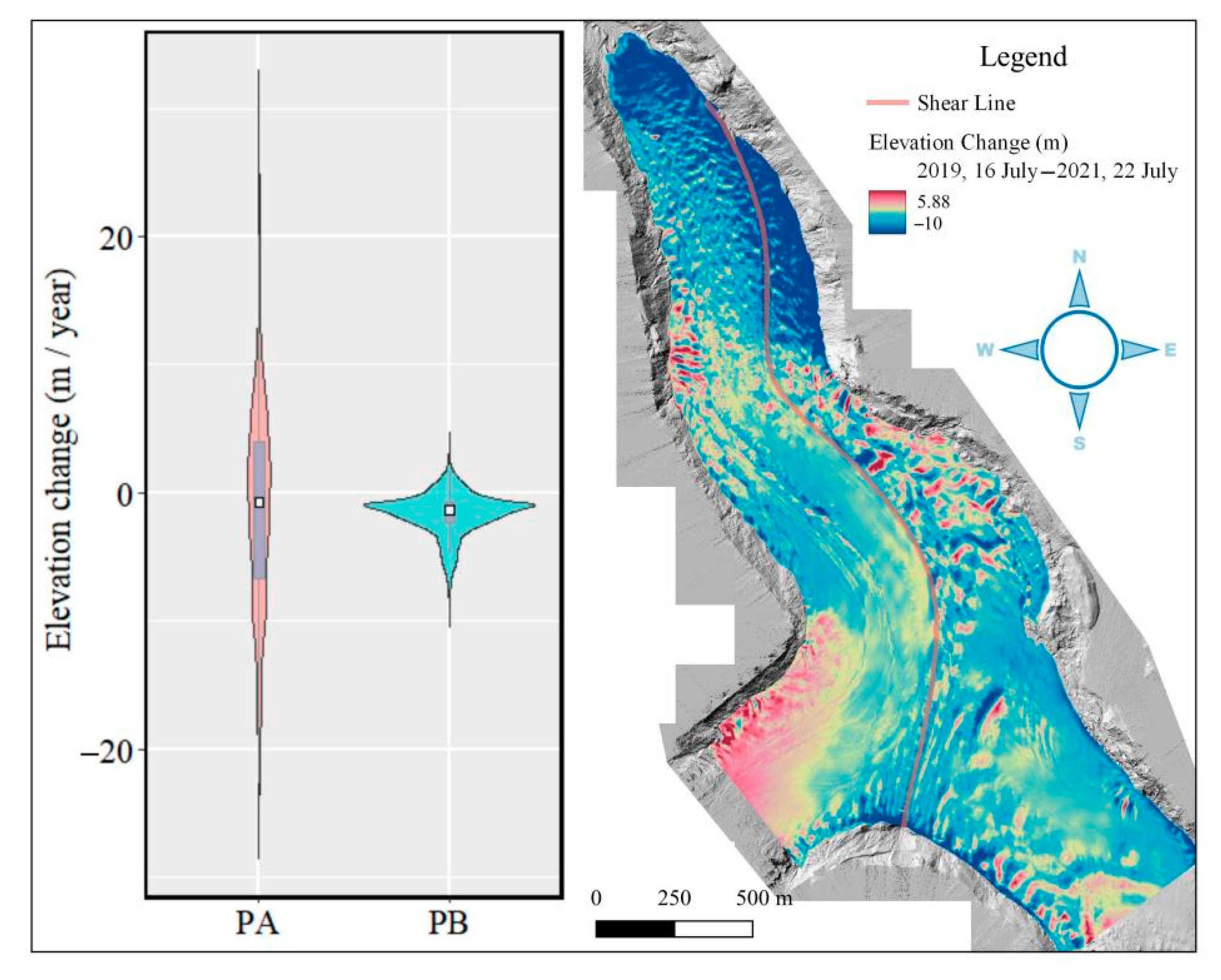
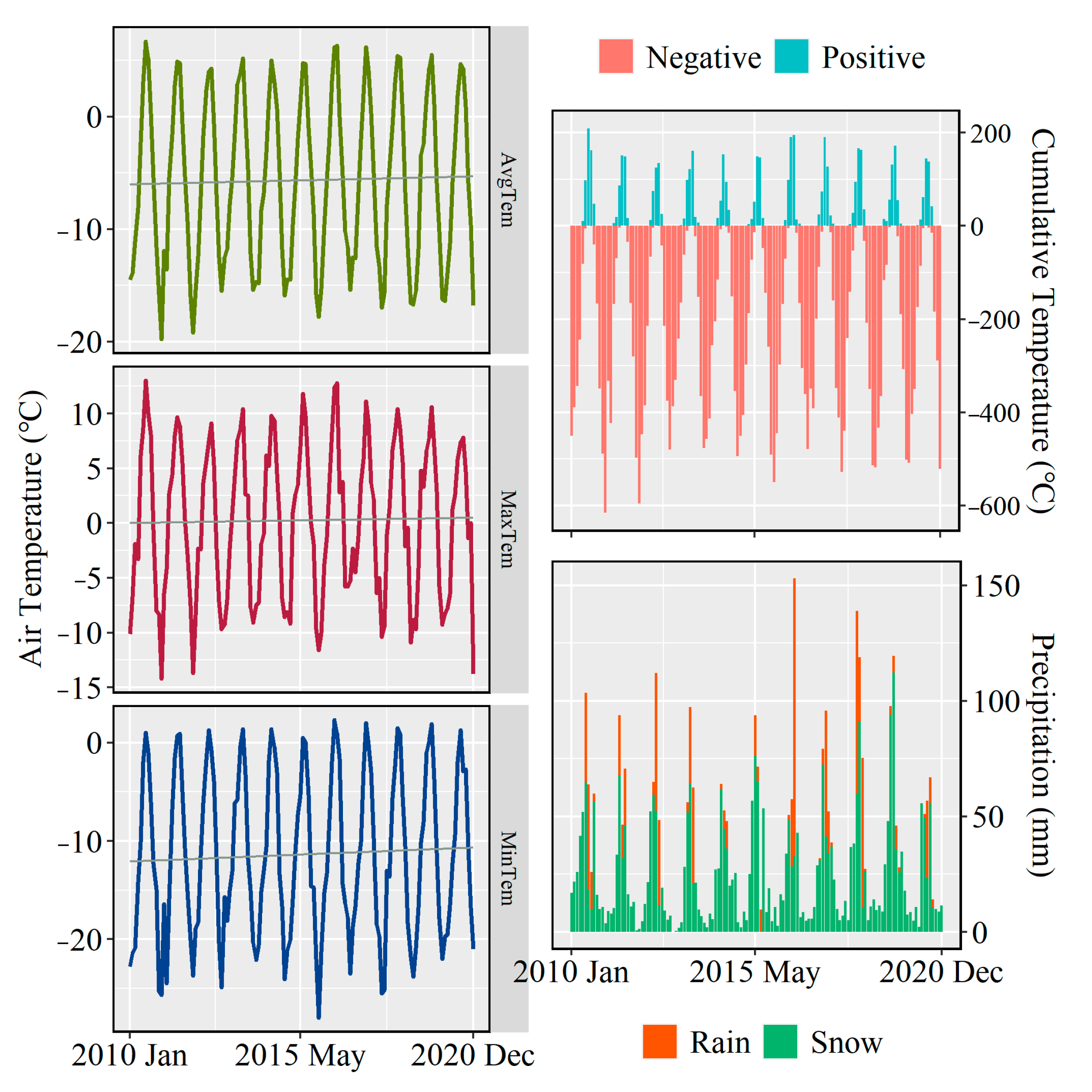
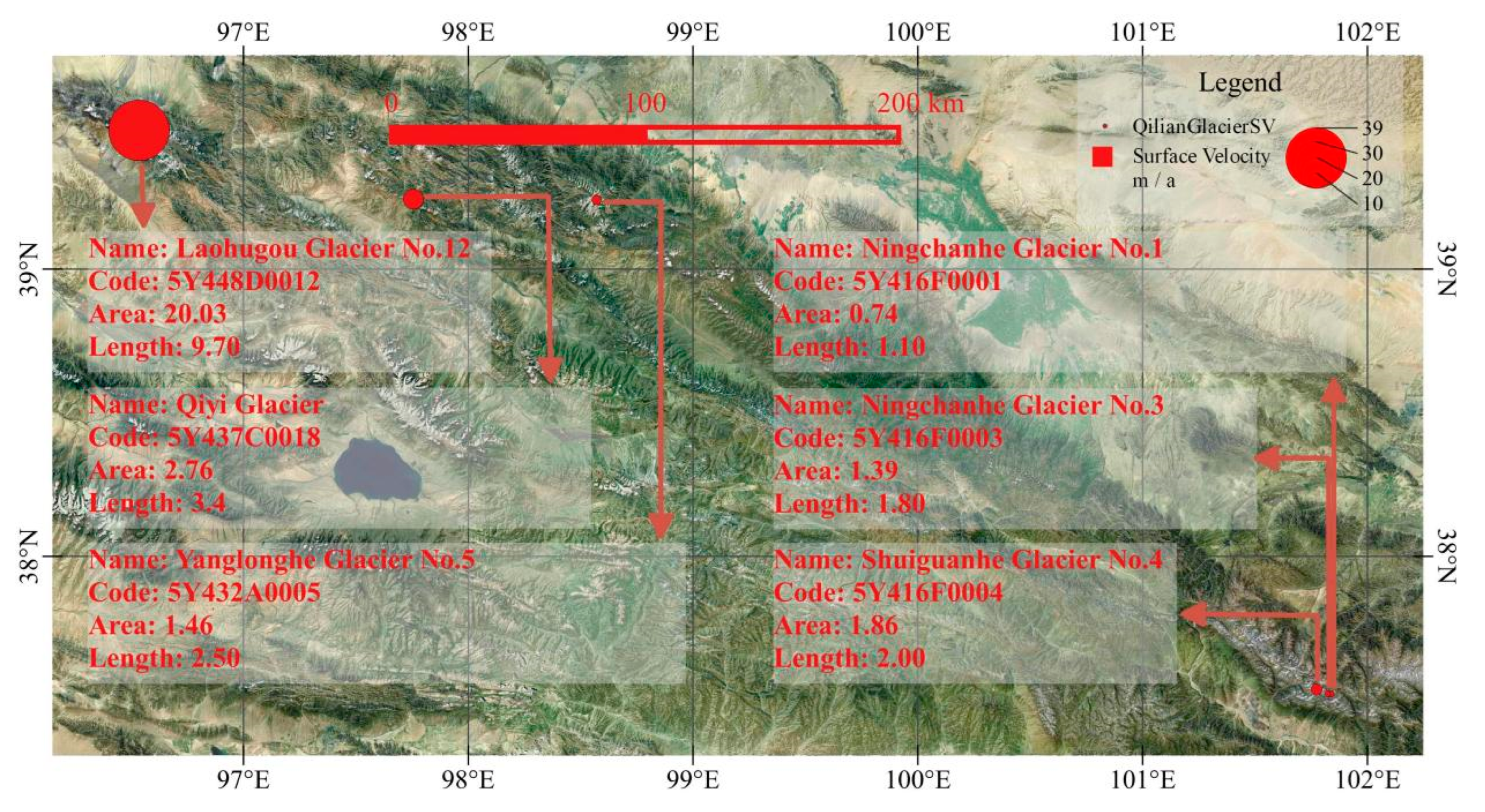
| Date | Drone | Flight Height (m) | Site | Overlap (%) | GSD (cm) | GNSS |
|---|---|---|---|---|---|---|
| 24 August 2017 | P4P | 120 | 3 | 75 | 3.27 | SOUTH S86 |
| 21 July 2018 | P4P | 120 | 12 | 75 | 3.27 | SOUTH S86 |
| 4 June 2019 | P4P | 120 | 12 | 75 | 3.27 | SOUTH S86 |
| 16 July 2019 | P4P | 120 | 12 | 75 | 3.27 | SOUTH S86 |
| 2 June 2021 | M2P | 150 | 12 | 75 | 3.51 | SOUTH INNO7 |
| 22 July 2021 | M2P | 150 | 12 | 75 | 3.51 | SOUTH INNO7 |
| 6 September 2021 | M2P | 150 | 12 | 75 | 3.51 | SOUTH INNO7 |
| Year | Area (km2) | Area Change (km2) | Annual Change Rate (%) |
|---|---|---|---|
| 2018 | 1.97 | ||
| 2019 | 1.96 | −0.01 | −0.51 |
| 2021 | 1.93 | −0.03 | −0.77 |
Publisher’s Note: MDPI stays neutral with regard to jurisdictional claims in published maps and institutional affiliations. |
© 2022 by the authors. Licensee MDPI, Basel, Switzerland. This article is an open access article distributed under the terms and conditions of the Creative Commons Attribution (CC BY) license (https://creativecommons.org/licenses/by/4.0/).
Share and Cite
Liu, Y.; Qin, D.; Jin, Z.; Li, Y.; Xue, L.; Qin, X. Dynamic Monitoring of Laohugou Glacier No. 12 with a Drone, West Qilian Mountains, West China. Remote Sens. 2022, 14, 3315. https://doi.org/10.3390/rs14143315
Liu Y, Qin D, Jin Z, Li Y, Xue L, Qin X. Dynamic Monitoring of Laohugou Glacier No. 12 with a Drone, West Qilian Mountains, West China. Remote Sensing. 2022; 14(14):3315. https://doi.org/10.3390/rs14143315
Chicago/Turabian StyleLiu, Yushuo, Dahe Qin, Zizhen Jin, Yanzhao Li, Liang Xue, and Xiang Qin. 2022. "Dynamic Monitoring of Laohugou Glacier No. 12 with a Drone, West Qilian Mountains, West China" Remote Sensing 14, no. 14: 3315. https://doi.org/10.3390/rs14143315





